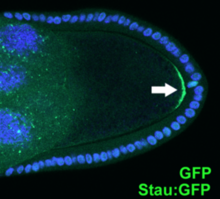Staufen (protein)
| Maternal effect protein staufen | |||||||
|---|---|---|---|---|---|---|---|
| Identifiers | |||||||
| Organism | |||||||
| Symbol | stau | ||||||
| UniProt | P25159 | ||||||
| |||||||
Staufen is a protein product of a maternally expressed gene first identified in Drosophila melanogaster. The protein has been implicated in helping regulate genes important in determination of gradients that set up the anterior posterior axis such as bicoid and oskar. Staufen proteins, abbreviated Stau, are necessary for cell localization during the oogenesis and zygotic development.[1] It is involved in targeting of the messenger RNA encoding these genes to the correct pole of the egg cell.[2][3]
Human homologs of this protein include STAU1 and STAU2.
Forms
[edit]Staufen proteins are categorized under a family of double stranded RNA-binding proteins.[4] Many homologs of Staufen proteins exist depending on the organism. The mammalian homologs of Staufen include STAU1 and STAU2.[5] The gene encoding the STAU1 protein is found along the long arm of chromosome 20, while the gene encoding STAU2 is found on chromosome 8.[6] These proteins are identified by the presence of double-stranded RNA binding domains (dsRNA- binding domains), which functions to bind the protein to double-stranded secondary structure RNAs.[7] These two orthologues are produced in several different isoforms following pre mRNA splicing.[5] STAU1 is predominantly expressed in most cell types, while STAU2 is conserved the brain, with low level expression in other cell tissues.[5]

Functions
[edit]Staufen proteins are encoded and produced very early in oogenesis. At the primary stages of oogenesis, Staufen mRNA is evenly disbursed throughout the cytoplasm of the cell.[8] As the oocyte develops, the proteins condense at the anterior margins and the posterior pole of the egg cell.[8] In Drosophila the proteins are necessary for the translating and transporting oskar mRNA to the posterior pole of the oocyte.[6] Similarly Staufen proteins are also part of a multistep process that localizes Bicoid mRNA to the anterior end of the early embryo, and these proteins are also responsible for asymmetric dispersion of prospero mRNA as the embryonic neuroblast divides.[9][6]
In mammals, the STAU proteins contain a microtubule-binding domain, giving the protein the capability to bind to Tubulin. Research has also shown that these proteins maintain an association with the Rough endoplasmic reticulum (RER), suggesting that transport of mRNA through the use of Staufen proteins is facilitated via the microtubule network to the rough endoplasmic reticulum.[7]
References
[edit]- ^ "Society for Developmental Biology | Home". www.sdbonline.org. Retrieved 2022-05-03.
- ^ Martin KC, Ephrussi A (February 2009). "mRNA Localization: Gene Expression in the Spatial Dimension". Cell. 136 (4): 719–30. doi:10.1016/j.cell.2009.01.044. PMC 2819924. PMID 19239891.
- ^ Houchmandzadeh B, Wieschaus E, Leibler S (February 2002). "Establishment of developmental precision and proportions in the early Drosophila embryo". Nature. 415 (6873): 798–802. Bibcode:2002Natur.415..798H. doi:10.1038/415798a. PMID 11845210. S2CID 4386630.
- ^ Almasi S, Jasmin BJ (December 2021). "The multifunctional RNA-binding protein Staufen1: an emerging regulator of oncogenesis through its various roles in key cellular events". Cellular and Molecular Life Sciences. 78 (23): 7145–7160. doi:10.1007/s00018-021-03965-w. PMC 8629789. PMID 34633481.
- ^ a b c Heraud-Farlow JE, Kiebler MA (September 2014). "The multifunctional Staufen proteins: conserved roles from neurogenesis to synaptic plasticity". Trends in Neurosciences. 37 (9): 470–479. doi:10.1016/j.tins.2014.05.009. PMC 4156307. PMID 25012293.
- ^ a b c Laver JD, Li X, Ancevicius K, Westwood JT, Smibert CA, Morris QD, Lipshitz HD (November 2013). "Genome-wide analysis of Staufen-associated mRNAs identifies secondary structures that confer target specificity". Nucleic Acids Research. 41 (20): 9438–9460. doi:10.1093/nar/gkt702. PMC 3814352. PMID 23945942.
- ^ a b "STAU1 staufen double-stranded RNA binding protein 1 [Homo sapiens (human)] - Gene - NCBI". www.ncbi.nlm.nih.gov. Retrieved 2022-05-03.
- ^ a b "Staufen". www.sdbonline.org. Retrieved 2022-05-03.
- ^ "Staufen". www.sdbonline.org. Retrieved 2022-04-27.
